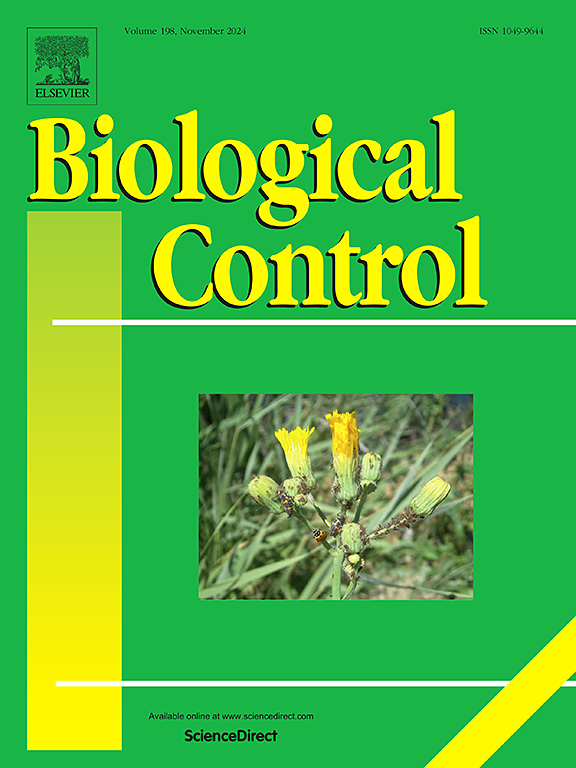Bacteria-based artificial diets modulate larval development, survival and gut microbiota of two insect pests
IF 3.4
2区 农林科学
Q2 BIOTECHNOLOGY & APPLIED MICROBIOLOGY
引用次数: 0
Abstract
Crop damage caused by insect pests results in substantial economic losses. The most widely used control methods, chemical pesticides, are losing efficacy and have deleterious environmental and health impacts. The goal of this study was to evaluate plant growth-promoting rhizobacteria (PGPR) strains blended as consortia for the management of insect pests through the impact on insect-gut microbiota. PGPR isolates were recovered from corn rhizosphere in Texas and characterized through 16S rRNA gene sequencing. Eight strains belonging to diverse taxa selected through prescreening were combined in three different blends (consortia), added into an insect artificial diet, and fed to larvae of corn earworm (Helicoverpa zea [Boddie, 1850]) and tobacco budworm (Chloridae virescens [Fabricius, 1777]). Insect growth and development was monitored, and gut microbiota was assessed through direct isolation and 16S rRNA sequencing approaches. The inoculated diet resulted in significant reduction in larval weight for both insect species compared to the control and caused changes in the taxonomic diversity and evenness of H. zea gut microbiota. The results of the isolation and 16S rRNA sequencing were generally in agreement and showed a higher population and dominance of bacilli but less diversity of other taxa in PGPR blend treatments compared to control. While the mechanism of the changes in gut microbiota is currently unknown, understanding how to utilize bacterial strains to manipulate insect’s gut microbiota and health is important for developing sustainable pest management strategies. Future studies should elucidate the mechanisms and how to effectively deploy these findings for field applications.
以细菌为基础的人工饲料调节两种害虫幼虫的发育、存活和肠道微生物群
虫害对农作物造成的损害导致了巨大的经济损失。最广泛使用的控制方法--化学农药--正在失去功效,并对环境和健康造成有害影响。本研究的目的是评估植物生长促进根瘤菌(PGPR)菌株作为联合菌株,通过对昆虫肠道微生物群的影响来治理害虫。从德克萨斯州的玉米根瘤菌群中分离出 PGPR 菌株,并通过 16S rRNA 基因测序对其进行鉴定。通过预筛选选出的属于不同类群的八种菌株被组合成三种不同的混合物(联合体),添加到昆虫人工饲料中,并喂给玉米穗虫(Helicoverpa zea [Boddie, 1850])和烟草芽虫(Chloridae virescens [Fabricius, 1777])幼虫。对昆虫的生长和发育进行了监测,并通过直接分离和 16S rRNA 测序方法对肠道微生物群进行了评估。与对照组相比,接种食物导致两种昆虫的幼虫体重显著下降,并导致 H. zea 肠道微生物群的分类多样性和均匀性发生变化。分离和 16S rRNA 测序的结果基本一致,表明与对照组相比,PGPR 混合处理中的芽孢杆菌数量较多,占优势,但其他类群的多样性较低。虽然肠道微生物群变化的机制目前尚不清楚,但了解如何利用细菌菌株来操纵昆虫的肠道微生物群和健康对于制定可持续的害虫管理策略非常重要。未来的研究应阐明这些机制以及如何有效地将这些发现应用于田间。
本文章由计算机程序翻译,如有差异,请以英文原文为准。
求助全文
约1分钟内获得全文
求助全文
来源期刊

Biological Control
生物-昆虫学
CiteScore
7.40
自引率
7.10%
发文量
220
审稿时长
63 days
期刊介绍:
Biological control is an environmentally sound and effective means of reducing or mitigating pests and pest effects through the use of natural enemies. The aim of Biological Control is to promote this science and technology through publication of original research articles and reviews of research and theory. The journal devotes a section to reports on biotechnologies dealing with the elucidation and use of genes or gene products for the enhancement of biological control agents.
The journal encompasses biological control of viral, microbial, nematode, insect, mite, weed, and vertebrate pests in agriculture, aquatic, forest, natural resource, stored product, and urban environments. Biological control of arthropod pests of human and domestic animals is also included. Ecological, molecular, and biotechnological approaches to the understanding of biological control are welcome.
 求助内容:
求助内容: 应助结果提醒方式:
应助结果提醒方式:


